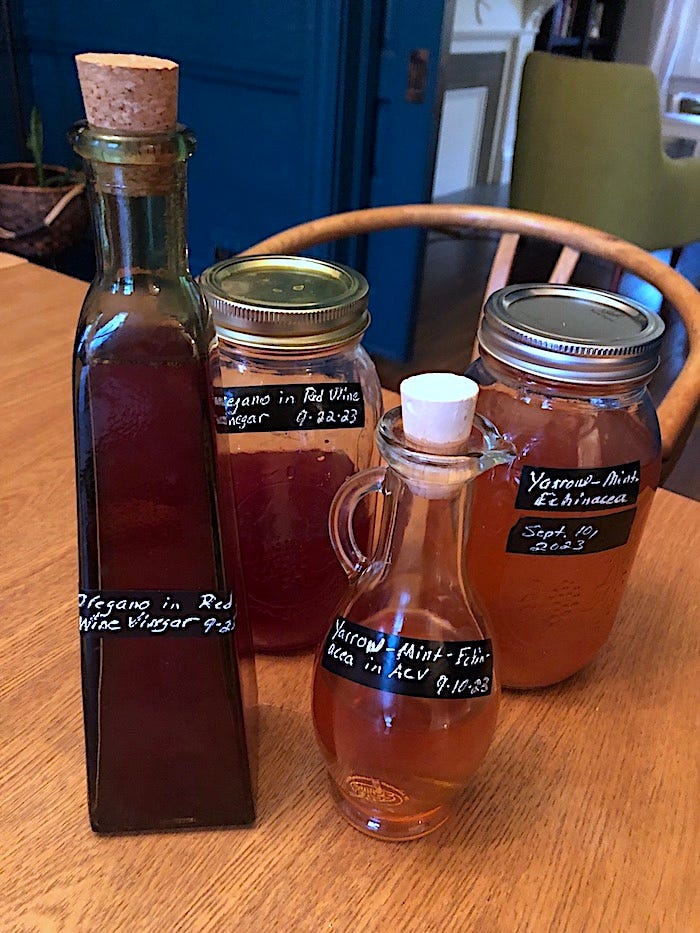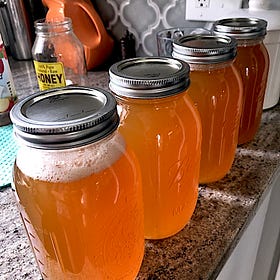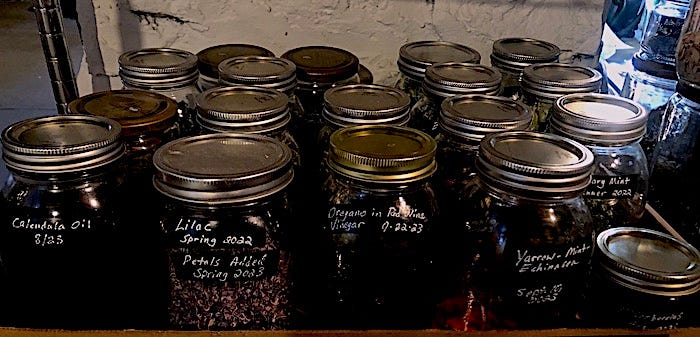Forging an herbal legacy
On chamomile tea and memory.
This first appeared as a guest post on The Herbalist’s Diary Substack.
“It’s chamomile, and you can make a tea out of it,” says my mother as she crouches down amidst a patch of little white flowers, like daisies but much smaller around, the stems growing lower to the ground. Her hair is the same pale yellow as the flower’s center, catching the low-angle Northwoods light. A lock sways in the breeze, falling into her face as she picks the flowers, and she tucks the hair neatly behind one ear.
I drop down to join her. She crushes the sunshiny head, smooshing it between her thumb and fingers. “Smell this.”
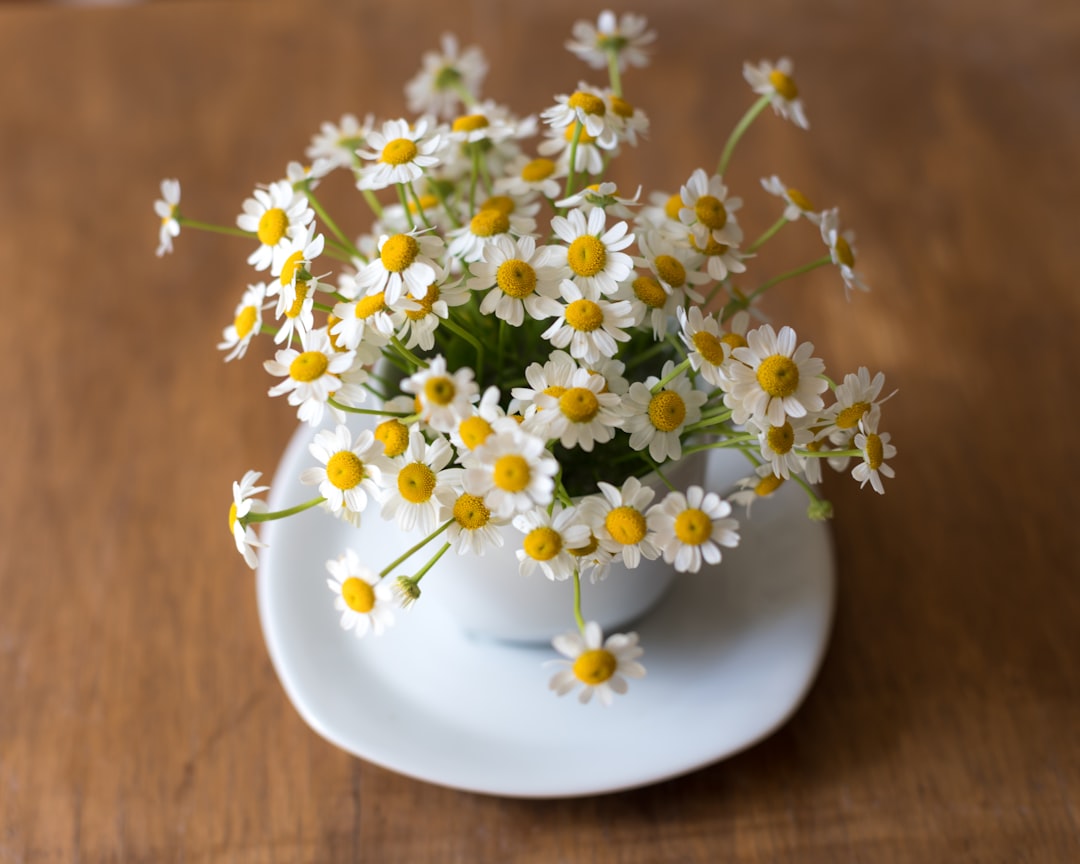
The scent wafts into my nostrils, like a mix of green apples and lemon peels, with a hint of Dad’s Old Spice. “It just grows here?” I ask. “Nobody planted it?”
“It just planted itself!” says my grandmother, cackling at her own joke as she stands there, watching us. Her hearing aids whistle, a high-pitched tone that buzzes my ears, and she reaches up to adjust them. They’re attached to the frame of her glasses, which to my snarky 80s point of view are totally outdated: cat’s-eye shaped, the wrong color, and thick like the bottoms of old Coke bottles. She smiles. “Nuts.” It’s her signature curse word, uttered when life’s just too ridiculous to do anything about.
My sister is there, too, completing the set of three generations of women. Our brothers, “the boys,” are probably off with Dad somewhere, visiting other family or at the go-kart track. We collect the chamomile in a Tupperware bowl and take it back to Grandma Pete’s house, where we boil water and steep it for tea. I marvel at the way the flowers tint the water in my cup a mild, yellowish green.
This is my only memory like this, one telling of an herbal legacy passed down from previous generations.
My mother was a stay-at-home mom with four kids in the 70s and 80s, and she embraced convenience foods and the standard American drug-store remedies. We drank Kool-Aid and ate Hamburger Helper; when we were sick, it was Nyquil that got the job done.
But something happened when we visited her home town. Maybe it was being around her own mother, or maybe it was the sense of rootedness you gain when returning to the small town where you grew up, but she was the one who’d hatched this particular plan to forage in a nearby schoolyard for chamomile. It wasn’t my grandmother; famously, I once went in search of fresh fruit while staying in her house, and all I could find was a can of peaches, “in heavy syrup.”
Mom’s influence on me with that chamomile was clear: As soon as I was out and about in the world on my own, I sought herbs for all that ailed me.
While in college during my late teens, I worked part-time for a little health-food store that sold bulk herbs and boxed teas. The manager was a trained herbalist who wore a white lab coat with his name embroidered on the pocket, his hair in a comb-over. I asked if I could apprentice with him, and he laughed out loud and showed me how to hot wax the floors.
But I learned to drink mullein tea for my perpetual winter cough, cleavers to detoxify, and echinacea to combat colds and flu.
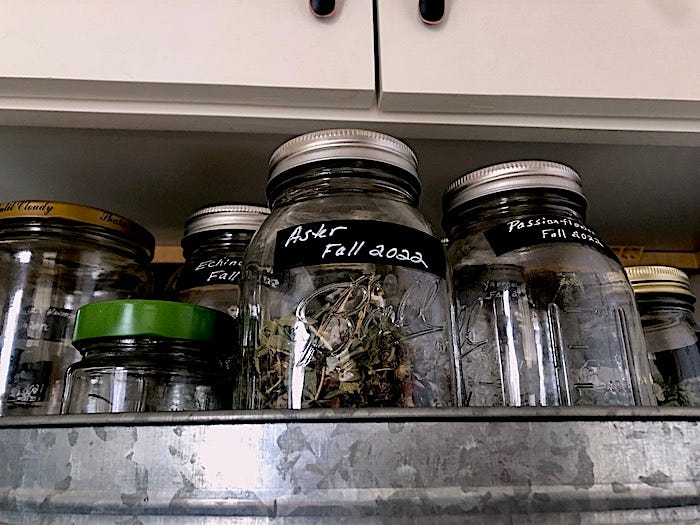
I wish I could tell you a heartwarming story about the kindly herbalist who taught me so much, but my “apprenticeship” ended as quickly as it began. He said, “Any man would go crazy in here looking at legs like those” the day I wore leggings to work, and he was more interested in checking me out with his eyes than sharing his fount of wisdom. That was more than I could put up with for minimum wage and a few tidbits of herbal advice, so I quit.
But I left armed with a stack of herbal encyclopedias and a quest for knowledge, and thus began my lifetime of self-study. Herbal tea has always been firmly in my wheelhouse, beginning with chamomile as the perfect calming drink before bed. As soon as I could afford as much as a balcony space, I’ve grown herbs myself, whether that’s hardy oregano or mint in pots or my current hugelkultur herb mound, set right outside our kitchen door as a key component of our quarter-acre food forest.
I harvest many of our native plants, beneficial non-natives, and standard kitchen herbs for both culinary and medicinal use. Here’s what’s hanging from my basement rafters right now:
ashwagandha
cleavers
brown-eyed Susan (just the stems, roots, and leaves, as the flower seeds are toxic)
evening primrose
echinacea
geranium
goldenrod
motherwort
passionflower
valerian
yarrow
coriander and dill (for seeds)
oregano, lemon balm, and sage
mint (both European and our native mountain mint)
Supplementing my book knowledge has also been important to me, so I’ve engaged the services of trained herbalists no matter where I’ve lived. Though our American health insurance rarely covers these expenses, it’s worth the out-of-pocket cost for the guidance and skill of a practiced herbalist. From them I’ve learned you can use fresh-grated nutmeg in warm milk to help you sleep, that ashwagandha works more powerfully if nutmeg’s not enough, and that elderberries are an excellent immune-system support. I grow an elderberry variety that is native to us and preserve it every year in a honey-vinegar oxymel that contains zero sugar and lasts all winter.
Elderflower oxymel and gooseberry-elderflower jam
By Lisa Brunette If you’re not growing elderberries and gooseberries, you might want to consider it. Elderberries are a powerhouse medicinal, as evidenced by the widespread use of elderberry syrup, especially during the winter season. The flower is edible as well, and together with its berry, elder is one of the oldest-known medicinals, with a number of historical uses both by Native Americans and Europeans. Many texts refer to it as a “
As my interest in ancestral traditions has increased with age, I’ve gravitated toward older folk uses and the histories around them, like this lovely elderberry piece from your very own Sarah Donoghue.
The best remedy for pre-menstrual syndrome in my experience, by the way, is a mix of herbs I take in a tincture that my cheeky herbalist calls “Not Today, Period.” It’s good when herbalists don’t take themselves too seriously and have a sense of humor.
In an attempt to broaden my herbal skills and knowledge, I’ve taken classes as well, such as one recently at the Missouri Botanical Garden. The teacher shared a valuable resource: the Native American ethnobotany database online, a searchable catalog of recorded uses of native plants by indigenous people. That’s a good reminder, too, that place can trump ancestry. Though my own lineage leads back to the British Isles, even if my ancestors did have homeland wisdom to pass down to me, they would have depended upon the kindness and tutelage of those who were already here in order to find the remedies they needed in the wild.
I’ve learned by trial and error that chamomile doesn’t grow very well where I live now, in the humid subtropics, so heading back to the Northwoods of Wisconsin must have triggered Mom’s herbal memories, as it grows so well there, with the cooler temperatures and low-angle sunlight. While these days I wouldn’t chance a public schoolyard for foraging unless I knew for sure the groundskeepers didn’t use herbicides, I can look back and deeply admire Mom’s impulse. Look at all it set in motion for that snarky 80s teen!




